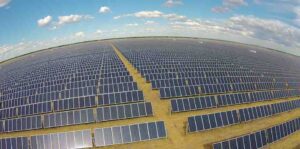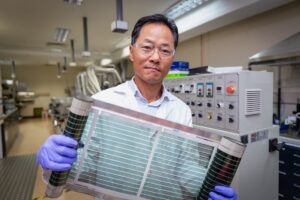A new report from Australian think tank Climate Energy Finance says booming solar investments is leading to a potential tipping point which could “dramatically accelerate the decline of the incumbent fossil fuel industry, and the decarbonisation of the world economy.”
Climate Energy Finance (CEF), established in 2022 by leading Australian clean energy expert Tim Buckley, published its new report Wednesday, entitled ‘Solar pivot: A massive global solar boom is disrupting energy markets and speeding the transition’.
Combining comprehensive analysis of a raft of developments core to the ongoing boom in solar investments, the report concludes that we are on the verge of “a series of global cascading energy tipping points” that could dramatically reshape the global energy landscape.
With solar investments booming, a trend which CEF sees as accelerating in 2023, solar is already the cheapest source of new electricity generation in a number of markets around the world.
But, according to CEF’s Buckley, the raft of developments underway across the sector means that “the economics of solar power are now compelling, and will only get stronger this decade.”
These include the combined momentum of rapid ongoing solar price deflation (polysilicon prices down two-thirds to-date in 2023), dramatic increases in solar manufacturing capacity globally (led by a trebling of scale in China) and successive record solar deployments.
Coupled with the surge in electric vehicles, battery supply chains and ‘electrification of everything’, it creates the conditions for a series of global cascading energy tipping points that have the potential to dramatically accelerate the decline of the incumbent fossil fuel industry.
According to the report, solar capacity additions have seen record annual levels every year this decade, and leading energy analysts BNEF predict a global record of 268GW in 2022.
CEF therefore predicts that the world could reach 1,000GW per annum of solar installations by 2030, resulting in “profound implications for electricity and energy markets globally.”
Solar module manufacturing capacity is similarly growing, with BNEF estimating 2022 levels had reached 600GW. CEF concludes that announced solar manufacturing expansions will double capacity by 2024-25, though this production capacity will naturally be centred in China.
“The implications for the acceleration of the global energy market transition are profound, raising the prospect of a chance to address the climate crisis at the speed the science dictates,” Buckley says.
CEF also highlighted the International Energy Agency’s (IEA) consistent underestimation of the rate of solar deployments, as well as the massive deflation of solar generation costs and resulting disruption to the global fossil fuel industry.
The IEA World Energy Outlook 2022 estimates 462 GW of annual solar installs to 2030 under its Net Zero by 2050 scenario. However, CEF expects that there will likely be “manufacturing capacity for world installs of double this.”
The report also looks at country specific solar levels, which are – as always – led by China, which is set to install between 120 and 140GW of solar in 2023 alone.
CEF expects this could increase to as much as approximately 260GW each year by 2030, accounting for between 40-60% of global annual renewable energy installations.
However, there is growth outside of China as well, notably in the United States and Australia.
The United States’ Inflation Reduction Act (IRA) which was passed in 2022 is driving a 5-times expansion in solar manufacturing capacity by 2024, according to CEF, and a doubling of solar installations to between 40-50GW per annum by 2030.
Similarly, in Australia, 30GW of solar was installed by the end of 2022 and the country – despite its size and mid-level population – is the sixth largest solar market in the world.
CEF expects Australian solar installations to continue at between 4 to 6GW each year, including 3GW of rooftop solar additions annually.
But CEF also concludes that, “with appropriate policy settings and capital investment, abundant land, sun and wind and other competitive advantages enable Australia to position itself as a renewables superpower.”










